
|
Chemistry |
Phenyl |
|
Separation Mode |
Reversed Phase |
|
Particle Substrate |
Hybrid |
|
pH Range Min |
1 pH |
|
pH Range Max |
12 pH |
|
Maximum Pressure |
6000 psi (415 Bar) |
|
Endcapped |
Yes |
|
Bonding Technology |
2-methyl-2-phenylethyl |
|
Silanol Activity |
Low |
|
Particle Shape |
Spherical |
|
Particle Size |
3.5 µm |
|
Endfitting Type |
Waters |
|
Pore Size |
125 Å |
|
Format |
Column |
|
Surface Area |
175 |
|
System |
HPLC |
|
USP Classification |
L11 |
|
Inner Diameter |
4.6 mm |
|
Length |
100 mm |
|
Carbon Load |
12 % |
|
UNSPSC |
41115709 |
|
Brand |
XTerra |
|
Product Type |
Columns |
|
Units per Package |
1 pk |

XTerra Phenyl Column, 125Å, 3.5 µm, 4.6 mm X 100 mm, 1/pk
The XTerra Phenyl Column, a critical piece of laboratory equipment, can give complementary selectivity to straight-chain alkyl stationary phases, particularly for molecules with aromatic rings. Additionally, it provides good peak shapes for all substances, reproducible retention times, strong pH stability, excellent surface coverage, and consistent retention times. This is made feasible by the successful coupling of Xterra phenyl chemistry and hybrid particle technology, which results in a unique stationary phase with these exceptional properties.
You should have the XTerra Phenyl Column in your collection of scientific tools because it is a reversed-phase hybrid column with the ability to operate as a phenyl ligand. These first-generation Xterra columns have greater pH stability than silica-based columns.
The di-functional bonding chemistry of the short-chain phenyl ligand in the XTerra Phenyl Column also improves the column's low pH hydrolytic stability. The use of this special substrate and ligand adds a new level of selectivity to complex mixture separations.
Waters Hybrid Particle Technology is used in the production of the packing materials for the XTerra Phenyl Column. The fact that the XTerra particles combine both organic (organosiloxane) and inorganic (silica) elements allow them to benefit from the best of both worlds. Comparing this hybrid technique to reversed-phase packing materials based on silica will increase pH stability and separation efficiency. To control the chemical composition and purity of the Hybrid particle, only ultrapure chemicals are utilized in the manufacture of XTerra Columns. Throughout the production process, each column is examined separately, and all operations are carried out within very precise tolerances. Each column is given a certificate of batch analysis and column efficiency.
To match your chromatographic needs, the XTerra Columns are available in a variety of porosity and particle sizes. You can learn more about them in our catalog or online and shop for lab equipment via one of those resources.
We recommend you also have a look into XTerra Phenyl VanGuard Cartridge, 125 Å, 3.5 µm, 3.9 mm x 5 mm, 3/pk; XTerra Phenyl VanGuard Cartridges are used to extend the lifetime and performance of analytical columns by removing particle pollution from the mobile phase stream. This cartridge offers protection for all 3.9 mm and 4.6 mm I.D. XTerra Phenyl analytical columns with 3.5 µm sorbent particles.
What Impact Does Polarity Have On The Separation Process In Chromatography?
Polar molecules travel further when polar solvents are used instead of non-polar solvents because they are more drawn to polar solvents. The distance that spots move and the solvent's overall movement can be compared and measured.